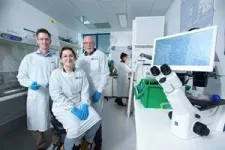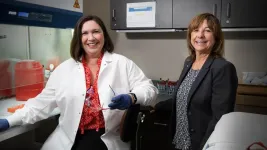(Press-News.org) The universe is humming with gravitational radiation — a very low-frequency rumble that rhythmically stretches and compresses spacetime and the matter embedded in it.
That is the conclusion of several groups of researchers from around the world who simultaneously published a slew of journal articles in June describing more than 15 years of observations of millisecond pulsars within our corner of the Milky Way galaxy. At least one group — the North American Nanohertz Observatory for Gravitational Waves (NANOGrav) collaboration — has found compelling evidence that the precise rhythms of these pulsars are affected by the stretching and squeezing of spacetime by these long-wavelength gravitational waves.
"This is key evidence for gravitational waves at very low frequencies,” says Vanderbilt University’s Stephen Taylor, who co-led the search and is the current chair of the collaboration. “After years of work, NANOGrav is opening an entirely new window on the gravitational-wave universe."
Gravitational waves were first detected by the Laser Interferometer Gravitational-Wave Observatory (LIGO) in 2015. The short-wavelength fluctuations in spacetime were caused by the merger of smaller black holes, or occasionally neutron stars, all of them weighing in at less than a few hundred solar masses.
The question now is: Are the long-wavelength gravitational waves — with periods from years to decades — also produced by black holes?
In one paper from the NANOGrav consortium, published Aug. 1 in The Astrophysical Journal Letters (ApJ Letters), University of California, Berkeley, physicist Luke Zoltan Kelley and the NANOGrav team argued that the hum is likely produced by hundreds of thousands of pairs of supermassive black holes — each weighing billions of times the mass of our sun — that over the history of the universe have gotten close enough to one another to merge. The team produced simulations of supermassive black hole binary populations containing billions of sources and compared the predicted gravitational wave signatures with NANOGrav’s most recent observations.
The black holes' orbital dance prior to merging vibrates spacetime analogous to the way waltzing dancers rhythmically vibrate a dance floor. Such mergers over the 13.8-billion-year age of the universe produced gravitational waves that today overlap, like the ripples from a handful of pebbles tossed into a pond, to produce the background hum. Because the wavelengths of these gravitational waves are measured in light years, detecting them required a galaxy-sized array of antennas — a collection of millisecond pulsars.
"I guess the elephant in the room is we're still not 100% sure that it's produced by supermassive black hole binaries. That is definitely our best guess, and it's fully consistent with the data, but we're not positive," said Kelley, UC Berkeley assistant adjunct professor of astronomy. "If it is binaries, then that's the first time that we've actually confirmed that supermassive black hole binaries exist, which has been a huge puzzle for more than 50 years now."
"The signal we're seeing is from a cosmological population over space and over time, in 3D. A collection of many, many of these binaries collectively give us this background," said astrophysicist Chung-Pei Ma, the Judy Chandler Webb Professor in the Physical Sciences in the departments of astronomy and physics at UC Berkeley and a member of the NANOGrav collaboration.
Ma noted that while astronomers have identified a number of possible supermassive black hole binaries using radio, optical and X-ray observations, they can use gravitational waves as a new siren to guide them where in the sky to search for electromagnetic waves and conduct detailed studies of black hole binaries.
Ma directs a project to study 100 of the closest supermassive black holes to Earth and is eager to find evidence of activity around one of them that suggests a binary pair so that NANOGrav can tune the pulsar timing array to probe that patch of the sky for gravitational waves. Supermassive black hole binaries likely emit gravitational waves for a couple of million years before they merge.
Other possible causes of the background gravitational waves include dark matter axions, black holes left over from the beginning of the universe — so-called primordial black holes — and cosmic strings. Another NANOGrav paper appearing in ApJ Letters today lays out constraints on these theories.
"Other groups have suggested that this comes from cosmic inflation or cosmic strings or other kinds of new physical processes which themselves are very exciting, but we think binaries are much more likely. To really be able to definitively say that this is coming from binaries, however, what we have to do is measure how much the gravitational wave signal varies across the sky. Binaries should produce far larger variations than alternative sources," Kelley said. "Now is really when the serious work and the excitement get started as we continue to build sensitivity. As we continue to make better measurements, our constraints on the supermassive black hole binary populations are just rapidly going to get better and better."
Galaxy mergers lead to black hole mergers
Most large galaxies are thought to have massive black holes at their centers, though they're hard to detect because the light they emit — ranging from X-rays to radio waves produced when stars and gas fall into the black hole — is typically blocked by surrounding gas and dust. Ma recently analyzed the motion of stars around the center of one large galaxy, M87, and refined estimates of its mass — 5.37 billion times the mass of the sun — even though the black hole itself is totally obscured.
Tantalizingly, the supermassive black hole at the center of M87 could be a binary black hole. But no one knows for sure.
"My question for M87, or even our galactic center, Sagittarius A*, is: Can you hide a second black hole near the main black hole we've been studying? And I think currently no one can rule that out," Ma said. "The smoking gun for this detection of gravitational waves being from binary supermassive black holes would have to come from future studies, where we hope to be able to see continuous wave detections from single binary sources."
Simulations of galaxy mergers suggest that binary supermassive black holes are common, since the central black holes of two merging galaxies should sink together toward the center of the larger merged galaxy. These black holes would begin to orbit one another, though the waves that NANOGrav can detect are only emitted when they get very close, Kelley said — something like 10 to 100 times the diameter of our solar system, or 1,000 to 10,000 times the Earth-sun distance, which is 93 million miles.
But can interactions with gas and dust in the merged galaxy make the black holes spiral inward to get that close, making a merger inevitable?
"This has kind of been the biggest uncertainty in supermassive black hole binaries: How do you get them from just after galaxy merger down to where they're actually coalescing," Kelley said. "Galaxy mergers bring the two supermassive black holes together to about a kiloparsec or so — a distance of 3,200 light years, roughly the size of the nucleus of a galaxy. But they need to get down to five or six orders of magnitude smaller separations before they can actually produce gravitational waves."
"It could be that the two could just be stalled," Ma noted. "We call that the last parsec problem. If you had no other channel to shrink them, then we would not expect to see gravitational waves."
But the NANOGrav data suggest that most supermassive black hole binaries don't stall.
"The amplitude of the gravitational waves that we're seeing suggests that mergers are pretty effective, which means that a large fraction of supermassive black hole binaries are able to go from these large galaxy merger scales down to the very, very small subparsec scales," Kelley said.
NANOGrav was able to measure the background gravitational waves, thanks to the presence of millisecond pulsars — rapidly rotating neutron stars that sweep a bright beam of radio waves past Earth several hundred times per second. For unknown reasons, their pulsation rate is precise to within tenths of milliseconds. When the first such millisecond pulsar was found in 1982 by the late UC Berkeley astronomer Donald Backer, he quickly realized that these precision flashers could be used to detect the spacetime fluctuations produced by gravitational waves. He coined the term "pulsar timing array" to describe a set of pulsars scattered around us in the galaxy that could be used as a detector.
In 2007, Backer was one of the founders of NANOGrav, a collaboration that now involves more than 190 scientists from the U.S. and Canada. The plan was to monitor at least once each month a group of millisecond pulsars in our portion of the Milky Way galaxy and, after accounting for the effects of motion, look for correlated changes in the pulse rates that could be ascribed to long-wavelength gravitational waves traveling through the galaxy. The change in arrival time of a particular pulsar signal would be on the order of a millionth of a second, Kelley said.
"It's only the statistically coherent variations that really are the hallmark of gravitational waves," he said. "You see variations on millisecond, tens of millisecond scales all the time. That's just due to noise processes. But you need to dig deep down through that and look at these correlations to pick up signals that have amplitudes of about 100 nanoseconds or so."
The NANOGrav collaboration monitored 68 pulsars in all, some for 15 years, and employed 67 in the current analysis. The group publicly released their analysis programs, which are being used by groups in Europe (European Pulsar Timing Array), Australia (Parkes Pulsar Timing Array) and China (Chinese Pulsar Timing Array) to correlate signals from different, though sometimes overlapping, sets of pulsars than used by NANOGrav.
The NANOGrav data allow several other inferences about the population of supermassive black hole binary mergers over the history of the universe, Kelley said. For one, the amplitude of the signal implies that the population skews toward higher masses. While known supermassive black holes max out at about 20 billion solar masses, many of those that created the background may have been bigger, perhaps even 40 or 60 billion solar masses. Alternatively, there may just be many more supermassive black hole binaries than we think.
"While the observed amplitude of the gravitational wave signal is broadly consistent with our expectations, it's definitely a bit on the high side," he said. "So we need to have some combination of relatively massive supermassive black holes, a very high occurrence rate of those black holes, and they probably need to be able to coalesce quite effectively to be able to produce these amplitudes that we see. Or maybe it's more like the masses are 20% larger than we thought, but also they merge twice as effectively, or some combination of parameters."
As more data comes in from more years of observations, the NANOGrav team expects to get more convincing evidence for a cosmic gravitational wave background and what's producing it, which could be a combination of sources. For now, astronomers are excited about the prospects for gravitational wave astronomy.
"This is very exciting as a new tool," Ma said. "This opens up a completely new window for supermassive black hole studies."
NANOGrav's data came from 15 years of observations by the Arecibo Observatory in Puerto Rico, a facility that collapsed and became unusable in 2020; the Green Bank Telescope in West Virginia; and the Very Large Array in New Mexico. Future NANOGrav results will incorporate data from the Canadian Hydrogen Intensity Mapping Experiment (CHIME) radio telescope, which was added to the project in 2019.
The NANOGrav collaboration receives support from National Science Foundation Physics Frontiers Center award numbers 1430284 and 2020265, the Gordon and Betty Moore Foundation, NSF AccelNet award number 2114721, a Natural Sciences and Engineering Research Council of Canada (NSERC) Discovery Grant, and the Canadian Institute for Advanced Research (CIFAR).
END
After 15 years, pulsar timing yields evidence of cosmic background gravitational waves
Groups report evidence that the cosmos is filled with a background of gravitational waves likely due to mergers of supermassive black hole binaries
2023-08-09
ELSE PRESS RELEASES FROM THIS DATE:
Grant provides cancer research training experience to expand workforce for cancer prevention and control
2023-08-09
University of Arizona Cancer Center researchers were awarded a $1.5 million grant from the National Cancer Institute to deliver an intensive, multidisciplinary cancer prevention and control research training program for undergraduate and graduate students.
According to multiple principal investigators Jennifer Bea, PhD, and Cynthia Thomson, PhD, RD, the goal of the 10-week, full-time summer program is to motivate students to pursue a career in cancer prevention science.
“I am very concerned about the number of skilled scientists and clinicians retiring,” said Dr. Bea, co-leader of the UArizona Cancer ...
World’s largest study shows the more you walk, the lower your risk of death, even if you walk fewer than 5,000 steps
2023-08-09
The number of steps you should walk every day to start seeing benefits to your health is lower than previously thought, according to the largest analysis to investigate this.
The study, published in the European Journal of Preventive Cardiology [1] today (Wednesday), found that walking at least 3967 steps a day started to reduce the risk of dying from any cause, and 2337 steps a day reduced the risk of dying from diseases of the heart and blood vessels (cardiovascular disease).
However, the new analysis of 226,889 people from 17 different studies around the world has shown that the more you walk, the greater the health benefits. ...
Theory meets practice
2023-08-09
(Santa Barbara, Calif.) — Scientific findings don’t always translate neatly into actions, especially in conservation and resource management. The disconnect can leave academics and practitioners disheartened and a bit frustrated.
“We want conservation science to be informing real-world needs,” said Darcy Bradley, a senior ocean scientist at The Nature Conservancy and a former director of UC Santa Barbara’s Environmental Markets Lab.
“Most managers and practitioners also want to incorporate science into their work,” ...
$4M NIH grant will test worksite sleep health coaching for Arizona firefighters
2023-08-09
A $4 million award from the National Heart, Lung, and Blood Institute, a division of the National Institutes of Health, will allow researchers in the University of Arizona Mel and Enid Zuckerman College of Public Health to identify key factors for the successful implementation of workplace sleep coaching to improve sleep health in Arizona firefighters.
Almost half of career firefighters report short sleep and poor sleep quality, and about 37% of firefighters screen positive for sleep disorders like sleep apnea, insomnia or ...
Chemical contamination on International Space Station is out of this world
2023-08-09
Concentrations of potentially harmful chemical compounds in dust collected from air filtration systems on the International Space Station (ISS) exceed those found in floor dust from many American homes, a new study reveals.
In the first study of its kind, scientists analysed a sample of dust from air filters within the ISS and found levels of organic contaminants which were higher than the median values found in US and Western European homes.
Publishing their results today in Environmental Science and Technology Letters, researchers from the University of Birmingham, UK, as ...
$150,000 awarded to research race in clinical algorithms
2023-08-09
DALLAS, August 8, 2023 — As part of a focused effort to assess current cardiovascular treatment algorithms for racial bias, the American Heart Association, the single largest non-government supporter of heart and brain health research in the U.S., is funding three new scientific research projects at $50,000 each.
Clinical algorithms are formulas, flow charts and computerized “calculators” that work behind the scenes to analyze health data and help determine a person’s risk for heart disease or guide their ...
New guidance on safe injection practice in hospitals emphasises the importance of prefilled and labelled syringes in avoiding medication errors
2023-08-09
New guidance published in Anaesthesia (the journal of the Association of Anaesthetists) provides clear advice to reduce avoidable errors on all steps of the pathway involving injectable medications used routinely in anaesthesia care. The guidance has been written by a working party of UK anaesthesia experts that include Dr Mike Kinsella, Honorary Consultant, Department of Anaesthesia, University Hospitals Bristol and Weston, Bristol, UK and Chair of the Working Party.
The authors explain: “Peri-operative medication safety is complex. Avoidance of medication ...
Health experts urge clinicians to ‘remain vigilant’ about malaria cases in new commentary
2023-08-08
FOR IMMEDIATE RELEASE
Tuesday, August 8, 2023
Contact:
Michael Saunders, msaunder@bu.edu
Jillian McKoy, jpmckoy@bu.edu
##
As worsening climate change and increased global travel create ideal conditions for a resurgence of malaria in areas where it has long been eradicated, clinicians must be vigilant of the disease’s symptoms and act swiftly once cases are detected, health experts warn in a new commentary published in the Annals of Internal Medicine.
In the last few months, Florida and Texas have reported ...
Inflammation slows malaria parasite growth and reproduction in the body
2023-08-08
Research led by the Peter Doherty Institute for Infection and Immunity (Doherty Institute) and the Kirby Institute found that inflammation in the body can slow down the development of malaria parasites in the bloodstream – a discovery that may constitute a potential new strategy for preventing or limiting severe disease.
A mosquito-borne disease, malaria is caused by Plasmodium parasites, which invade and multiply within red blood cells. Previous research has shown that the parasites can rapidly sense and respond to conditions within the host by intimately syncing with their internal body clocks. While it is known that the body’s nutrient levels and daily circadian rhythms affect ...
Mothers experiencing depression can still thrive as parents
2023-08-08
The proverb “It takes a village to raise a child” takes on new significance when a mother of a child is experiencing depression.
“Being a mother with depression carries increased risks for a child’s physical and psychological health,” says Dr. Sarah Dow-Fleisner, Assistant Professor in the School of Social Work and Director of the Centre for the Study of Services to Children and Families at UBC Okanagan. “But it’s not fated to be, especially if mothers have external supports.”
Dr. Dow-Fleisner’s findings, recently published in the ...
LAST 30 PRESS RELEASES:
Quantum ‘alchemy’ made feasible with excitons
‘Revoice’ device gives stroke patients their voice back
USF-led study: AI helps reveal global surge in floating algae
New method predicts asthma attacks up to five years in advance
Researchers publish first ever structural engineering manual for bamboo
National poll: Less than half of parents say swearing is never OK for kids
Decades of suffering: Long-term mental health outcomes of Kurdish chemical gas attacks
Interactional dynamics of self-assessment and advice in peer reflection on microteaching
When aging affects the young: Revealing the weight of caregiving on teenagers
Can Canada’s health systems handle increased demand during FIFA World Cup?
Autistic and non-autistic faces may “speak a different language” when expressing emotion
No clear evidence that cannabis-based medicines relieve chronic nerve pain
Pioneering second-order nonlinear vibrational nanoscopy for interfacial molecular systems beyond the diffraction limit
Bottleneck in hydrogen distribution jeopardises billions in clean energy
Lung cancer death rates among women in Europe are finally levelling off
Scientists trace microplastics in fertilizer from fields to the beach
The Lancet Obstetrics, Gynecology, & Women’s Health: Taking paracetamol during pregnancy does not increase risk of autism, ADHD or intellectual disabilities, confirms new gold-standard evidence review
Taking paracetamol during pregnancy does not increase risk of autism, ADHD or intellectual disabilities
Harm reduction vending machines in New York State expand access to overdose treatment and drug test strips, UB studies confirm
University of Phoenix releases white paper on Credit for Prior Learning as a catalyst for internal mobility and retention
Canada losing track of salmon health as climate and industrial threats mount
Molecular sieve-confined Pt-FeOx catalysts achieve highly efficient reversible hydrogen cycle of methylcyclohexane-toluene
Investment in farm productivity tools key to reducing greenhouse gas
New review highlights electrochemical pathways to recover uranium from wastewater and seawater
Hidden pollutants in shale gas development raise environmental concerns, new review finds
Discarded cigarette butts transformed into high performance energy storage materials
Researchers highlight role of alternative RNA splicing in schizophrenia
NTU Singapore scientists find new way to disarm antibiotic-resistant bacteria and restore healing in chronic wounds
Research suggests nationwide racial bias in media reporting on gun violence
Revealing the cell’s nanocourier at work
[Press-News.org] After 15 years, pulsar timing yields evidence of cosmic background gravitational wavesGroups report evidence that the cosmos is filled with a background of gravitational waves likely due to mergers of supermassive black hole binaries




